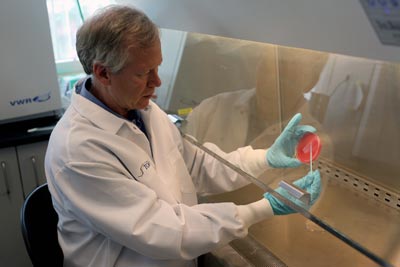Employing technology that reads the entire DNA code, researchers led by the Translational Genomics Research Institute and the Technical University of Denmark have pinpointed the source of a cholera outbreak in Haiti that killed more than 6,000 people and sickened 300,000.

Using whole genome sequencing, which spells out the billions of chemical bases in DNA, the team of researchers provided the strongest evidence yet that peacekeepers from Nepal, where cholera is widespread, brought the disease to Haiti. The Nepalese soldiers were responding to assist the island nation that was reeling from a devastating earthquake in January 2010 that killed more than 300,000. Paul Keim, Regents Professor of biology at Northern Arizona University and director of the TGen Pathogen Genomics Division, served as senior molecular biologist on the study, and NAU’s Center for Microbial Genetics and Genomics also contributed.
In the study, titled “Population genetics of Vibrio Cholerae from Nepal: An identical clone in Nepal and the Haitian outbreak,” researchers confirm the source of the cholera, and suggest how to prevent future outbreaks when international aid is rushed to disaster areas.
The study appeared Tuesday, Aug. 23, in mBio, a new online-only, open-access journal published by the American Society of Microbiology in partnership with the American Academy of Microbiology.
“The great similarity of Haitian cholera with Nepalese cholera is based upon the highest resolution DNA methods available, and point to a probable source of this devastating disease outbreak,” said Keim, who in 2001 assisted the FBI in tracking down the source of the anthrax letters case, which killed five people. He said similar genetic tracking techniques were used in investigating the Haitian cholera outbreak.
According to Keim, methods pioneered during the anthrax letter forensic investigation and today’s greatly diminished costs for whole genome sequencing make it possible to apply this powerful technology to new and critical public health challenges.
Keim praised TGen’s collaborators at the National Public Health Laboratory in Nepal, and at the National Food Institute in Denmark, where the study’s senior author, Frank M. Aarestrup, is head of the Antimicrobial Resistance and Molecular Epidemiology Unit.
Lance Price, an associate professor at TGen and co-author of the new study, said the investigation into the source of Haitian cholera could help prevent such outbreaks in the future.
“This effort validates the power of advanced molecular tools in investigating outbreaks of this nature,” Price said. “The goal now should be finding ways to prevent such outbreaks, perhaps through screening prior to deployment. This study is not about placing blame, it’s about preventing such disasters in the future.”
Researchers confirmed the source of the outbreak by comparing the DNA of 24 cholera samples (the bacterium Vibrio cholera) from five different districts in Nepal with 10 samples of cholera from Haiti. All 24 samples from Nepal matched the samples from Haiti. Some of the samples, the report said, “were almost identical.”



